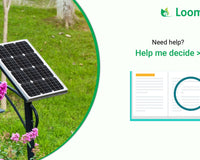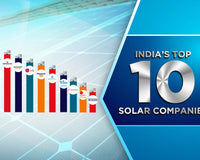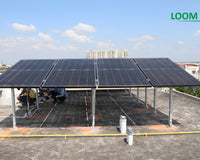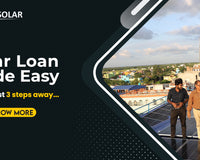Solar panels are super important for homes in Delhi because there's lots of sunshine here. They help you save money on electricity bills which is extra useful when the power goes out. The Delhi government is working to make more solar energy in the state. By 2030, it is anticipated that solar power will account for more than 50% of the consumption threshold established for Delhi.
Components of a Solar System
Solar Panels: Solar panels are the heart of any solar system. These panels are made up of photovoltaic cells that convert sunlight into electricity. Solar panels come in many variants like DCR solar panels, monocrystalline solar panels, and bifacial solar panels. The most prominent choice is bifacial solar panel for residential purpose.
Solar Inverter: Solar panels generate direct current (DC) electricity, but most of our household appliances use alternating current (AC). So, we need a solar inverter to convert DC into AC. On grid solar inverters are a crucial part of the system, they come in different sizes 3KW, 5 KW, 8 KW and 10 KW.
Solar Batteries (optional): Some solar power systems include batteries to store excess electricity for use during cloudy days or at night. This is especially valuable in places with unreliable grid power, making sure you have electricity even when the sun isn't shining.
Mounting Structure: Solar panels need to be securely mounted on rooftops or the ground. The mounting structure not only keeps them in place but also ensures they are at the right angle to receive maximum sunlight.
Charge Controller (if using batteries): The charge controller regulates the flow of electricity to and from the batteries, preventing overcharging and prolonging battery life.
Wiring: Proper wiring are essential to connect all the components of the system safely and efficiently. These wires transport electricity from the solar panels to the inverter, batteries (if present), and then to your home or the grid.
How to apply for Net Metering?
Net metering is important for solar subsidies in delhi because it helps more people use clean energy. With net metering, solar panel owners can sell extra electricity back to the DISCOM and earn money. This encourages more people to choose solar power, which is good for the economy.
To apply for a net meter in delhi, follow these simple steps:
- Search BSES Delhi for applying net meter.
- Now two tabs will appear you Can click on anyone tab – BSEB Rajdhani Power Limited or BSES Yamuna Power Limited.
- Now Click on New Connection. Then Click on Solar Rooftop Net-Metering, it redirects on www.solarbses.com official website.
- Click on “Apply” tab on the top blue panel. Check the “Net metering application” tab.
- Click on “Login” option if you are an existing customer or “Register” if you are a new customer.
- Now, You will receive consumer number and password on your registered email id.
- Now login using your email and password. After logging in, you have to input information like CA No, Sanctioned Load, and System Capacity Proposed, etc.
- Go on File Upload. You have to upload documents like application form, capacity proof, ID proof, electricity bill, NOC, etc.
Type of Rooftop Solar System
On Grid Solar System: If you want to reduce your electricity bill up to 80% then on grid solar system is an optimal choice for you. An on-grid solar system, also known as a grid-tied solar system, that system is connected to the electricity grid, and this will help you to save money form the electricity bills. As well as you can sell excess generated electricity back to the DISCOM and earn money with that.
Off Grid Solar System: If you live in a remote area or experience frequent power cuts, you may want to consider an off-grid solar system. An off-grid solar system includes batteries to store excess power for use during times when the sun is not shining.
Hybrid Solar System: A hybrid solar system is a combination of an “on-grid” and “off-grid solar systems”. It is basically a grid connected system that comes with a battery backup. So, it has the advantage of both you can store excess power in the battery for use during an emergency time as well as you can sell the surplus generated power to the grid and earn money.
According, to the solar professional “Hybrid Solar System” is the optimal choice because from this you can reduce your electricity bill as well as get power backup during emergency time. This makes it a popular choice for residential installations.
Solar Panel Subsidy Scheme
Both central and state government offer subsidies schemes to people for installation the rooftops solar system.
Central government subsidy scheme:
Central government subsidy scheme is known as DBT (Direct Bank Transfer). In this scheme the subsidy amount will be directly transfer into the customers bank account with in the 30 days of commissioning of the solar system. You can get central government subsidy by applying through the National Portal for Solar Portal.
State government subsidy scheme:
Although the Delhi government does not offer any additional subsidy, there is a central government portal through which any residential consumer from across India can avail the financial incentive. Through the recently launched National Portal for Rooftop Solar, one can directly apply for subsidy online and track the entire process from application submission to transfer of funds to the respective bank account.
Solar Panel Subsidy Price
| Capacity | Central Subsidy | |
| 2 KW | 29,176 | |
| 3 KW | 43,764 | |
| 4 KW | 51,058 | |
| 5 KW | 58,352 | |
| 6 KW | 65,646 | |
| 7 KW | 72,940 | |
| 8 KW | 80,234 | |
| 9 KW | 87,528 | |
| 10 KW | 94,822 |
Both central and state offers the solar subsidy, for the general category states the central government pay 30% amount for the total as a subsidy. But for special states like Himachal Pradesh, Uttarakhand, Sikkim, J&K and Lakshadweep the central government pays the 70% subsidy amount. If your state doesn’t offer the subsidy on solar you can avail the central government subsidy by applying through the National Portal for Solar Portal.
If you want to interest in getting a subsidy you need to follow some guidelines. You must contact the electricity provider or DISCOM and apply online with the necessary documents. Their person will visit your site for a review and gives you an approval. Then the electricity provider visits for inspection. Customers can then avail the subsidy amount.
What is the entire process?
To apply solar subsidy, you should follow the following steps:
Step 1: Site Survey. Book Engineer Visit from here.
Step 2: System Capacity, Costing & Performance Analysis
Step 3: Buy Solar System & Installation
Step 4: Apply for Net Metering
Step 5: Get Solar Subsidy after 30 days of rooftop solar panel installation.











